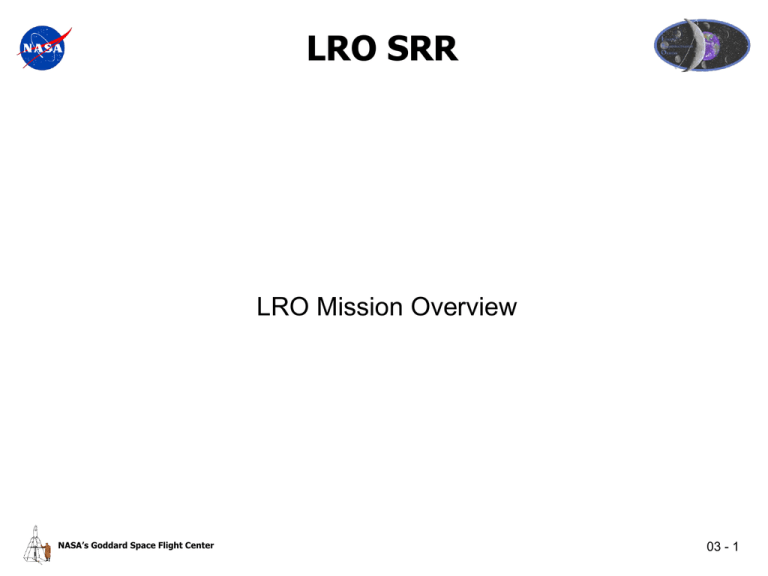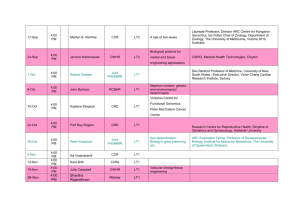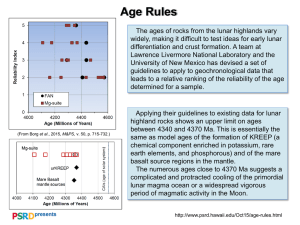LRO SRR LRO Mission Overview 03 - 1 NASA’s Goddard Space Flight Center
advertisement

LRO SRR LRO Mission Overview NASA’s Goddard Space Flight Center 03 - 1 2008 Lunar Reconnaissance Orbiter (LRO) First Step in the Robotic Lunar Exploration Program Robotic Lunar Exploration Program LRO Objectives • Characterization of the lunar radiation environment, biological impacts, and potential mitigation. Key aspects of this objective include determining the global radiation environment, investigating the capabilities of potential shielding materials, and validating deep space radiation prototype hardware and software. • Develop a high resolution global, three dimensional geodetic grid of the Moon and provide the topography necessary for selecting future landing sites. • Assess in detail the resources and environments of the Moon’s polar regions. • High spatial resolution assessment of the Moon’s surface addressing elemental composition, mineralogy, and Regolith characteristics NASA’s Goddard Space Flight Center 03 - 2 LRO Mission Overview Science and Exploration Objectives ICE (Resources) Human adaptation Biological adaptation to lunar environment (radiation, gravitation, dust...) Topography & Environments Environs Polar Regions GEOLOGY Prepare for Human Exploration Understand the current state and evolution of the volatiles (ice) and other resources in context Develop an understanding of the Moon in support of human exploration (hazards, topography, navigation, environs) When • Where • Form • Amount NASA’s Goddard Space Flight Center 03 - 3 LRO Project Start-UP Instrument Selection Instrument A/B Contract Awards Project Funded Level 1 Requirements Baselined Mission SRR Requirements Definition & Preliminary Design 1/05 2/05 3/05 Instrument K.O. Mtg. NASA’s Goddard Space Flight Center 4/05 5/05 6/05 7/05 8/05 9/05 Instrument Accommodation Rvw. 03 - 4 LRO Mission Overview Flight Plan – Direct using 3-Stage ELV • • • • Launch on a Delta II rocket into a direct insertion trajectory to the moon. On-board propulsion system used to capture at the moon, insert into and maintain 50 km altitude circular polar reconnaissance orbit. 1 year mission Orbiter is a 3-axis stabilized, nadir pointed spacecraft designed to operate continuously during the primary mission. Moon at encounter Cis-lunar transfer 5.1978 day transfer Launch C3 –2.07 km2/s2 Sun direction Lunar Orbit Cis-Lunar Transfer 1-day Insertion and Circularization Impulsive Vs (m/s) 1 – 344.24 2 – 113.06 3 – 383.91 4 – 11.45 5 – 12.18 100 and 50km mission orbits Earth 6-hour orbit Nominal Cis-lunar Trajectory 12-hour orbit Solar Rotating Coordinates NASA’s Goddard Space Flight Center 03 - 5 LRO Mission Overview Orbiter INSTRUMENT MODULE Preliminary LRO Characteristics CRaTER Mass 1480 kg LOLA Power ( bus orbit ave.) 823 W AVIONICS MODULE Measurement Data Volume 575 Gb/day LROC LRO Instruments LAMP PROPULSION MODULE SOLAR ARRAY • Lunar Orbiter Laser Altimeter (LOLA) Measurement Investigation – LOLA will determine the global topography of the lunar surface at high resolution, measure landing site slopes and search for polar ices in shadowed regions. • Lunar Reconnaissance Orbiter Camera (LROC) – LROC will acquire targeted images of the lunar surface capable of resolving small-scale features that could be landing site hazards, as well as wide-angle images at multiple wavelengths of the lunar poles to document changing illumination conditions and potential resources. • Lunar Exploration Neutron Detector (LEND) – LEND will map the flux of neutrons from the lunar surface to search for evidence of water ice and provide measurements of the space radiation environment which can be useful for future human exploration. • Diviner Lunar Radiometer Experiment – Diviner will map the temperature of the entire lunar surface at 300 meter horizontal scales to identify cold-traps and potential ice deposits. • Lyman-Alpha Mapping Project (LAMP) – LAMP will observe the entire lunar surface in the far ultraviolet. LAMP will search for surface ices and frosts in the polar regions and provide images of permanently shadowed regions illuminated only by starlight. • Cosmic Ray Telescope for the Effects of Radiation (CRaTER) – CRaTER will investigate the effect of galactic cosmic rays on tissue-equivalent plastics as a constraint on models of biological response to background space radiation. Mini-RF INSTRUMENT MODULE AVIONICS MODULE HGA LAMP PROPULSION MODULE LEND Diviner SOLAR ARRAY NASA’s Goddard Space Flight Center 03 - 6 LRO Mission Phases Overview No 1 Phase Pre-Launch/ Launch Readiness 2 Launch & Lunar Transfer 3 Sub-Phases Space Segment Readiness Ground Segment Readiness Launch and Ascent Separation and De-spin Deployment and Sun Acq. Lunar Cruise Lunar Orbit Insertion Includes all activities & operations from launch countdown sequence to Lunar Orbit Insertion (LOI). LOI includes all maneuvers necessary to obtain the temporary parking orbit for Orbiter activation and commissioning. During the cruise phase, initial spacecraft checkout will be performed to support activities for mid course correction (MCC) and LOI. Spacecraft Commissioning Integrated Instrument Commissioning Configure and checkout the spacecraft subsystems and ground systems prior to instrument turn-on. Instrument integrated activation will be developed to complete instruments turn-on and commissioning. Instrument commissioning includes any calibration activities needed in the temporary orbit. Measurements (Routine Ops) Station-keeping Momentum Management Instrument Calibrations Lunar Eclipse Yaw Maneuver Safe Mode Orbiter Commissioning 4 Routine Operations Includes instrument I&T, spacecraft/orbiter I&T, space/ground segment testing as well as operations preparation and ground readiness testing leading up to launch. One year of nominal science collection in the 50 (+/- 20) km orbit. Extended Mission Operations After 1-year of science observations, orbiter will be boosted into a higher orbit to reduce maintenance requirements. Potential purpose for extended mission operations may be to perform relay comm. operations. Alternatively additional measurement operations may be performed for a shorter period in a continued low orbit. End-of-Mission Disposal Includes planning and execution of end-of-life operations. LRO will impact lunar surface. 5 6 Description NASA’s Goddard Space Flight Center 03 - 7 LRO Mission Schedule LRO Mission Schedule Ver. 0.9 7/31/05 Task 2004 CY Q2 Q3 2005 Q4 Q1 Q2 AO Release Q3 2006 Q4 IPDR LRO Mission Milestones Q1 PDR Q2 ICDR Q3 2007 Q4 Q1 CDR Q2 Q3 M RD SRR Q1 Q2 2009 Q3 Q4 FOR/ORR M OR Conf. Review Q1 Q2 Q3 Q4 Launch IPSR IBR AO Sel. 2008 Q4 PSR PER M RR LRR Mission Feasibility Definition Payload Proposal Development Instr. PDR's 9/6-9/30 Payload Preliminary Design System Definition S/C &GDS/OPS Preliminary Design Payload Design (Final) (1M Float) Spacecraft Design (Final) Network Acquisition GDS/OPS Definition/ Design Payload Fab/Assy/Test (7 Instruments) Payload com plete (Final Delivery to I&T) (LAMP/LOLA/LROC/Diviner/CraTer/LEND/M ini-RF) S/C Fab/Assy/Bus Test S/C com plete (Final delivery to I&T) GND Net Test Ready GDS/OPS Development Implemention & Test s/c subsy s s/c Pay load subsy s Integration and Test (1M Float) Ship to KSC s/c bus Launch Site Operations GDS s/c (1M Float) subsy s (1M Float) Launch Mission Operations Phase A/B NASA’s Goddard Space Flight Center Phase C/D Phase E 03 - 8 LRO SRR LRO Science Overview Dr. Gordon Chin NASA’s Goddard Space Flight Center 03 - 9 LRO Science Overview • LRO follows in the footsteps of the Lunar Orbiter missions which proceeded Apollo. • LRO will launch by 2008 to provide critically needed data to enable and to plan future Exploration objectives • LRO provides major exploration and scientific benefits by 2009 – Apollo provided first order information from a small region of the Moon; much more of the Moon needs to be explored – LRO objectives addresses future landing sites, polar resources, safety, and lunar science goals – LRO address both science and exploration objectives • LRO instrument suite complements international lunar missions – Six instruments competitively selected – Comparison to international missions demonstrate LRO uniqueness and value NASA’s Goddard Space Flight Center 03 - 10 Competitively Selected LRO Instruments Provide Broad Benefits INSTRUMENT CRaTER (BU+MIT) Measurement Exploration Benefit Science Benefit Tissue equivalent response to radiation Safe, lighter weight space vehicles that protect humans Radiation conditions that influence life beyond Earth 300m scale maps of Temperature, surface ice, rocks Determines conditions for systems operability and water-ice location Maps of frosts in permanently shadowed areas, etc. Locate potential waterice (as frosts) on the surface Hydrogen content in and neutron radiation maps from upper 1m of Moon at 5km scales, Rad > 10 MeV Locate potential waterice in lunar soil and enhanced crew safety ~50m scale polar topography at < 1m vertical, roughness Safe landing site selection, and enhanced surface navigation (3D) Geological evolution of the solar system by geodetic topography 1000’s of 50cm/pixel images (125km2), and entire Moon at 100m in UV, Visible Safe landing sites through hazard identification; some resource identification Resource evaluation, impact flux and crustal evolution Cosmic Ray Telescope for the Effects of Radiation Diviner (UCLA) LAMP (SWRI) Lyman-Alpha Mapping Project LEND (Russia) Lunar Exploration Neutron Detector LOLA (GSFC) Lunar Orbiter Laser Altimeter LROC (NWU+MSSS) Lunar Recon Orbiter Camera NASA’s Goddard Space Flight Center Improved understanding of volatiles in the solar system - source, history, migration and deposition 03 - 11 National Academy of Sciences NRC Decadal (2002) lists priorities for the MOON (all mission classes thru 2013) NRC Priority Investigation NRC approach LRO measurements Geodetic Topography (crustal evolution) Altimetry from orbit (with precision orbits) Global geodetic topography at ~100m scales (< 1 m rms) Local Geologic Studies In 3D (geol. Evolution) Imaging, topography (at m scales) Sub-meter scale imaging with derived local topography Polar Volatile Inventory Spectroscopy and mapping from orbit Neutron and IR spectroscopy in 3D context + UV (frosts) Geophysical Network (interior evolution) In situ landed stations with seismometers Crustal structure to optimize siting and landing safety Global Mineralogical Mapping (crustal evolution) Orbital hyperspectral mapping 100m scale multispectral and 5km scale H mapping Targeted Studies to Calibrate Impact Flux (chronology) NASA’s Goddard Space Flight Center Imaging and in situ geochronology Sub-meter imaging of Apollo sites for flux validation and siting 03 - 12 Comparison to International Systems Demonstrate Uniqueness and Value Reqt’s for LRO 2008 NASA LRO SELENE SMART-1 Chandrayaan (from NASA ORDT, and ESMD RLEP Reqt’s 9/04; NRC Decadal, 2002) [50km orbit, 1 yr+] Competed Payload (JAXA orbiter ~ 2007) [100km orbit, 1 yr] (ESA lunar 2005 orbiter) [250km periapsis] (ISRO 2007-2008 launch) [100+ km orbit] Radiation Environment Global assessment including neutrons, GCR Highly limited overlap in some narrow energy ranges Limited to some energy ranges TBD (imaging NS, Rad Sensor) Biological Adaptation Biological responses to radiation (Rad Sensor) Not addressed Not addressed Not addressed Shielding materials (test-beds) Shielding expt’s with TEP (Rad Sensor) Not addressed Not addressed Not addressed Geodetic topography (global) 10’s m x,y, with < 1m vertical precision, attn to poles (Lidar) 1.6 km x, y at > 20 m vertical precision (RMS) [not meet LRO goals] Not addressed Not addressed H mapping to assess ice Landform scale at 100 ppm (~5 km scale at poles) (imaging NS) 160km scale via GRS (does not meet LRO goals) Limited to 100’s of km scale (H) [does not meet LRO goals] Some potential, but depends on contributed sensors T mapping cold traps (polar) Landform scale at 3-5K (40-300K): ~300m scale Not addressed Not addressed TBD Not addressed in this mission (cf. GRS) Not addressed TBD (contributed S-band SAR Not addressed: best imaging is ~10m/pixel stereo, MS imaging (10+ VISNIR bands) Not addressed (best imaging is 10-100 m/pixel) Not addressed, but imaging (MS) will be included (10’s m/pixel) (IR mapper) Putative ice deposits at poles ~25-400m scales in shadows (Imager, Lidar, NS, IR, UV) Sub-meter imaging for landing site assessment Targeted, meter-scale feature detection, hazards (Imager, Lidar) and Mineral mapping from US?) Polar illumination High time-rate polar imaging (Imagers) Partially addressed, but frequency TBD? Limited TBD OTHER Far UV imaging for frosts and lunar atmosphere (farside gravity from lidar) Particles and Fields, Farside gravity, elemental chemistry Particles and Fields, etc. Likely (contributed mineralogy mapping?) NASA’s Goddard Space Flight Center 03 - 13


